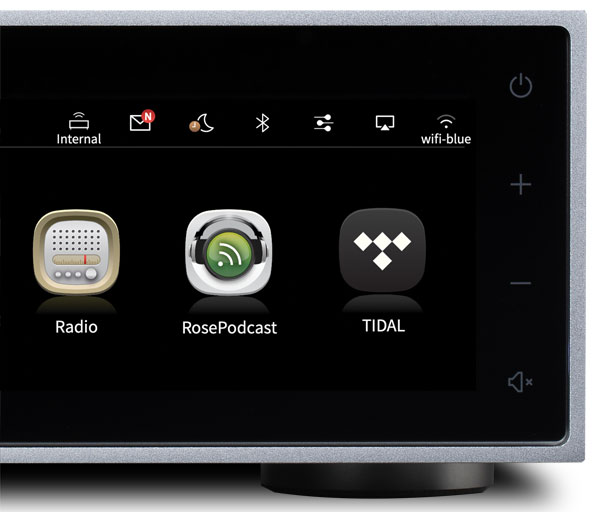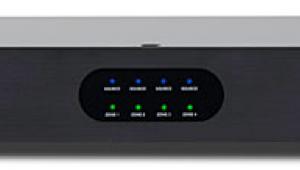You can stream everything in very good audio quality for so much less that I do not get where these units are so expensive. Must be for a much larger profit margin and a slightly better build. Not really worth that. My pick is the Cocktail Audio N25 which in The US is largely ignored.
HiFi Rose RS150 Streaming DAC Review Page 2
What's not included in the RS150's feature package? There's no amplifier, headphone output, room correction, or balanced analog inputs. And Bluetooth connectivity is only one-way. I don't fault the RS150 too much for omitting these things, however, since the many features that the RS150 does provide are all very useful.
Setup
Removing the RS150 from its box revealed a gorgeous, tank-like machine. Powering it up caused a tutorial to appear on the touchscreen, which is the largest and most ravishing that I've encountered on an A/V component. Doubtless due to the RS150's considerable computer processing power, the touchscreen functions with exceptional fluidity and a high level of responsiveness.
Using the RS150 as a DAC, preamplifier, and music streamer, I connected it to a pair of System Audio SA Saxo 5 powered speakers via a pair of RCA cables. I next connected an Ethernet cable, inserted the included Wi-Fi/Bluetooth dongle, paired the Bluetooth remote control, and selected my language and time zone, updated the unit's firmware, and entered my network password and Tidal and Qobuz credentials using the touchscreen controls.
My next step was to connect a USB storage drive containing music files. I also tried to download the RoseConnect app to my seven-year-old iPad Mini 2 running iOS12 but discovered that the app only works on iPads running iOS 13 and later. (HiFi Rose has a basic app called RoseWare that works with older devices, but I didn't use it, opting instead to control the RS150 with my iPhone.) For video, I ran a cable between the RS150's HDMI port and the one on my LG OLED TV, and also used the set's HDMI ARC port to route TV sound back to the RS150.

I mostly used the RS150 with its digital audio filter set to Apodizing Fast Roll-off and the signal upsampling option turned off. Upsampling the signal did increase perceived detail, but I found that the Native setting provided the most natural sound. (Bear in mind that digital setting choices are highly dependent on personal preference and the sonic characteristics of the amp and speakers used.)
Performance
The RS150 leaned toward a rich, weighty, and layered sound, reminding me more of Simaudio's Moon 280D ($3,000) than Linn's Majik DSM ($3,835), two stream-capable components I tested in the April/May and August/September 2021 issues, respectively. Soundstage size was larger than I've experienced with most streaming DACs, while images were clearly delineated and horizontally layered.
For reasons of order and context, I don't typically listen to classical compilation albums. Nonetheless, I started with Beethoven's iconic "Fifth Symphony, 1st Movement," from Evening Classical Chill Out with Beethoven, Mozart, & Greig (16-bit/44.1kHz FLAC, Tidal). The presentation was elegant and natural, with violins sounding full and sweet, and oboes powerful and expressive. Although not as pinpoint in its presentation of images as the Majik DSM, the RS150 clearly placed the symphony's string sections on the stage's left portion and within that area ordered high-frequency instruments like violins and lower-pitched ones like violas from left to right, with woodwinds placed accurately in-between.
On many tracks, the RS150's sound was not only flattering, but positively forgiving. Take "Can't We Be Friends," from another compilation, Ella Fitzgerald and Louis Armstrong Collection (16-bit/44.1kHz FLAC, Qobuz). This track suffers from a lack of transparency, strident trumpet and piano notes, and sibilants on Armstrong's vocals. The RS150 moderated the last two of these shortcomings and managed to do so without dulling voices.

The RS150's accommodating sonic balance was especially welcome with 1970s rock. Playing "Magic Bus," from The Who's Live at Leeds (24-bit/48kHz FLAC, Qobuz), it smoothed some of the electric guitar peaks that are especially apparent at high volumes with that track. And on "Sound Chaser," from Yes' Relayer (16-bit/44.1kHz FLAC, Tidal), the RS150 took a bit of the edge off a bright and otherwise sonically challenged recording.
The RS150's sound didn't want for detail. On "Magic Bus," it adroitly reproduced guitar riff echoes as they bounced off the venue's left wall. And on the opening low-frequency volleys of Igor Stravinsky's "The Firebird Suite" (24-bit/176.4kHz WAV), it was able to easily parse the timbres of the percussion, woodwind, and string instruments. Furthermore, the orchestral volleys sounded clean and were followed by finely textured percussive decays.
The above praise does not mean that the RS150 served up the proverbial free lunch. On "Magic Bus," it produced electric guitar riffs with slightly less energy and dynamism than I've heard with some other network players. And on "Let's Go (extended mix)," from Deadmau5's W:/2016ALBUM/ (16-bit/44.1kHz FLAC), the electronic pulses and bass beats sounded a bit polite and laid-back.
Checking out music videos from the RoseTube app on my TV, I found the picture quality to be stunning, and the same held for higher-quality regular YouTube videos streamed via the RS150. Audio received from the TV through the RS150's HDMI ARC port also sounded fine, though again, the quality varied with the specific video.

Moving to the RS150's touchscreen, static album art displayed while streaming from Tidal and Qobuz looked fantastic and covered virtually the entire 14.9 inches of screen real estate. Videos were displayed on a smaller square at the screen's center and high-quality ones looked fantastic. Most of the time, though, I set the RS150 to display one of the VU meter choices.
As a complex and fairly new product, the RS150 wasn't without bugs. For example, several of the Rose apps intermittently failed to work based on an apparent inability to connect with the company's server. However, after I notified HiFi Rose of the issue, an automatic firmware update was released that solved things. Other updates released during my evaluation period improved the RS150's already excellent menu system and added content to the Rose apps.
Conclusion
Most streaming DACs at the RS150's price point, and even above, don't provide anywhere near its mix of features, performance, aesthetics and build quality, and operational flexibility. It's also easy to listen to—a quality I find to be very important in a network music player. HiFi Rose could charge substantially more for the RS150 and I'd still give it a cracking review.
- Log in or register to post comments

As an Android-based device, isn't this limited by Android's audio limitations, such as all 44.1 kHz material being resampled to 48 kHz?
As someone who doesn't at all get the use case for one of these boxes, I'll (mostly) avoid commenting on the perceived value of $5k for something like this. Eesh.

My top pick is the Cocktail Audio N25. The playback of PCM and DSD signals of up to 32-bit/768kHz and DSD512 (22.5792Mhz), respectively, is supported by the RS150 thanks to ESS Technology's flagship Sabre ES9038PRO funny shooter 2 chipset, which is responsible for handling digital audio signal conversion within the RS150.

Overall, the HiFi Rose RS150 Streaming DAC is a top-performing audio device that delivers exceptional sound quality and versatility. Its high-resolution audio playback capabilities, convenient connectivity options, and sleek design make it a great option for audiophiles looking for a premium streaming DAC. However, it may be a bit pricey for budget-conscious consumers, and some users may find the touchscreen display to be too small for their liking. Nevertheless, if sound quality and performance are a top priority, the RS150 is definitely worth considering. So, if you're looking for a high-end streaming DAC that delivers audiophile-grade sound quality, the HiFi Rose RS150 is a solid choice. Overall, it is a worthy investment for serious audiophiles who demand the best in audio performance. With its high-resolution audio playback capabilities, versatile connectivity options, and sleek design, the RS150 is sure to impress even the most discerning audio enthusiasts. So, if you're looking for a top-performing streaming DAC that delivers uncompromising sound quality, the HiFi Rose RS150 is definitely worth considering. Whether drywall contractors near me detroit listening to your favorite music through headphones or a high-end audio system, the RS150 is sure to elevate your listening experience to new heights. So, if you're serious about audio quality and want a premium streaming DAC that delivers exceptional performance, the HiFi Rose RS150 is a top contender

This is kinda expensive, I'm sure that you can find many devices like this one for at least half the price and about the same quality, I don't really get why someone would buy this one. I think that someone in my personal Highest Rated Heat Pump Replacement in Gainesville, Florida has a Toshiba device like this one and it honestly sounds really good!































































